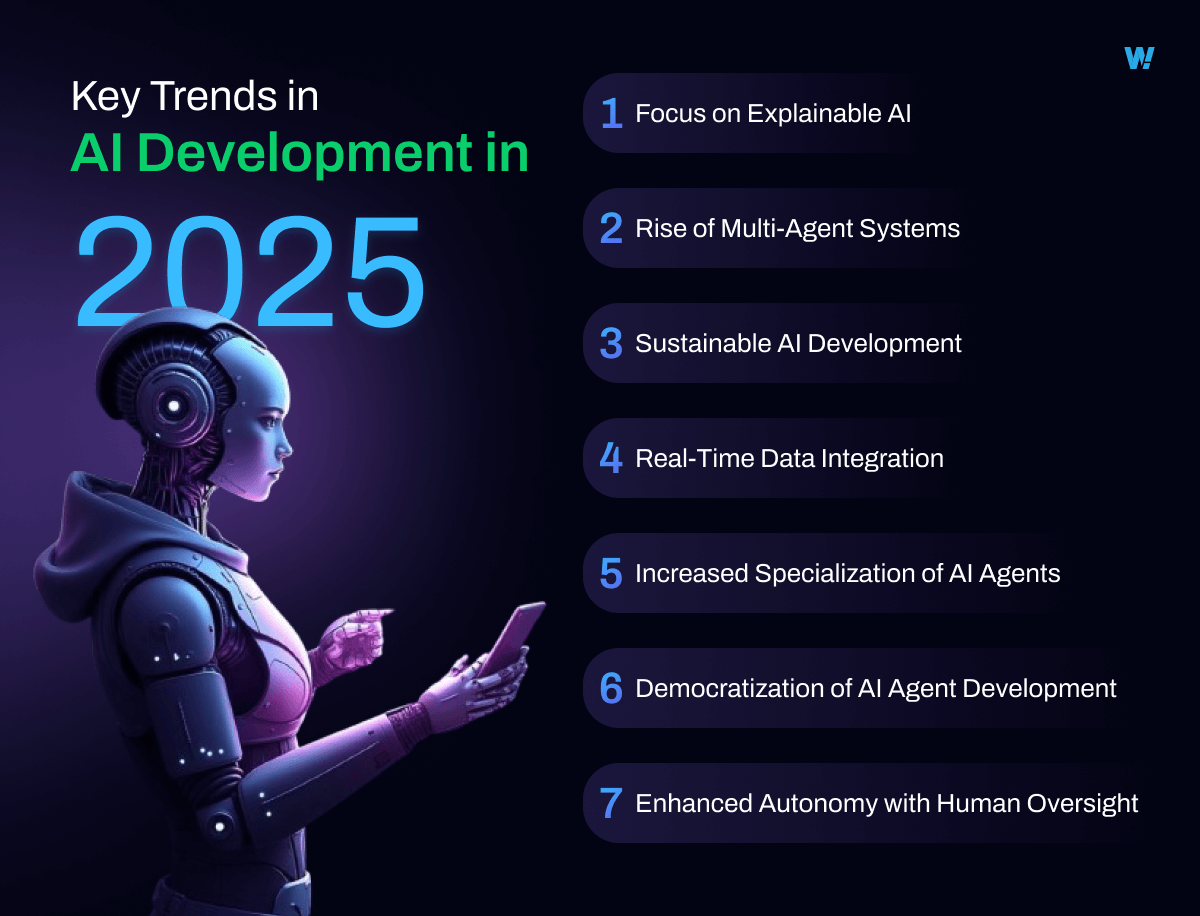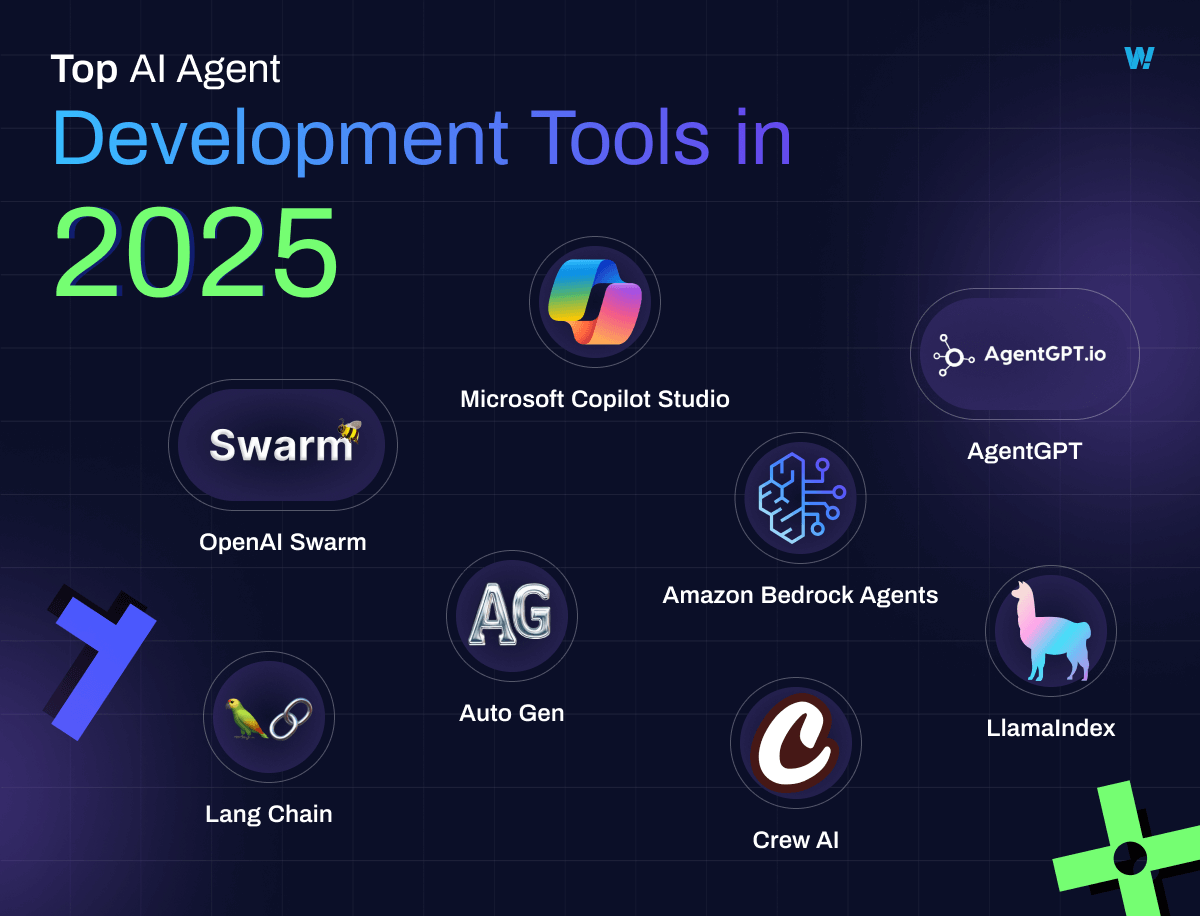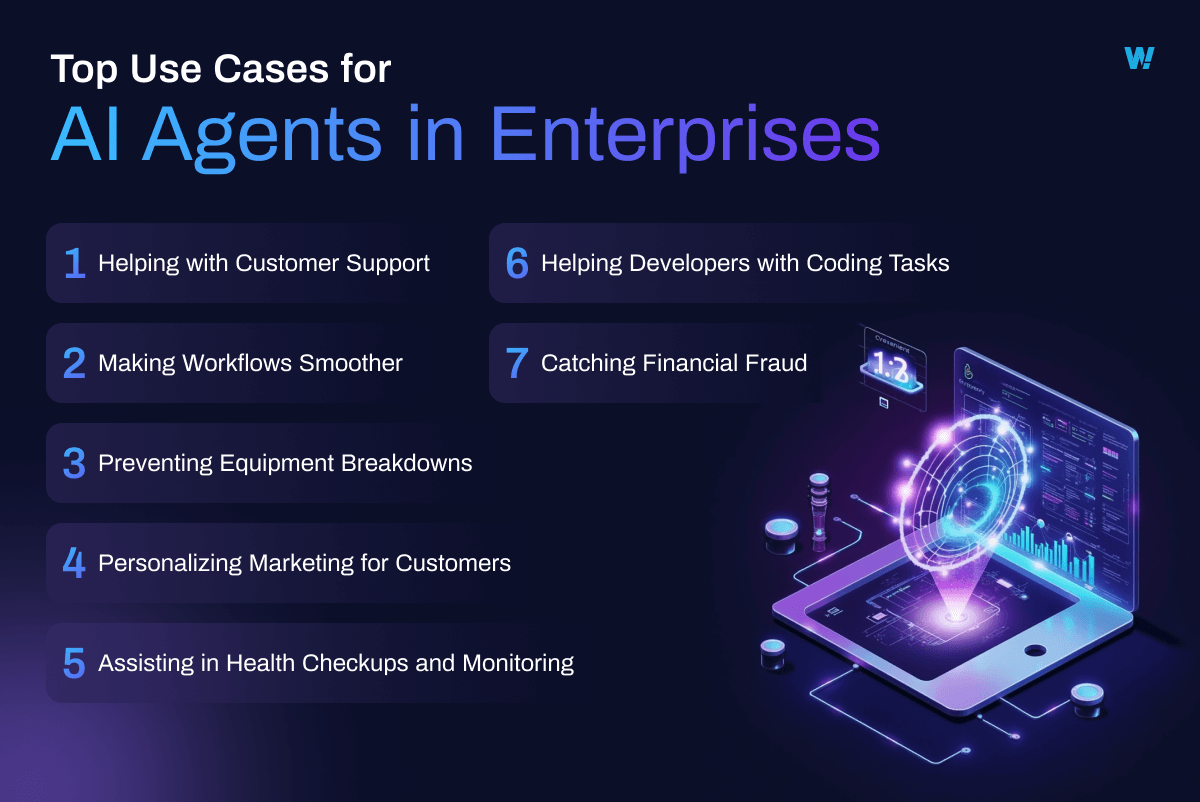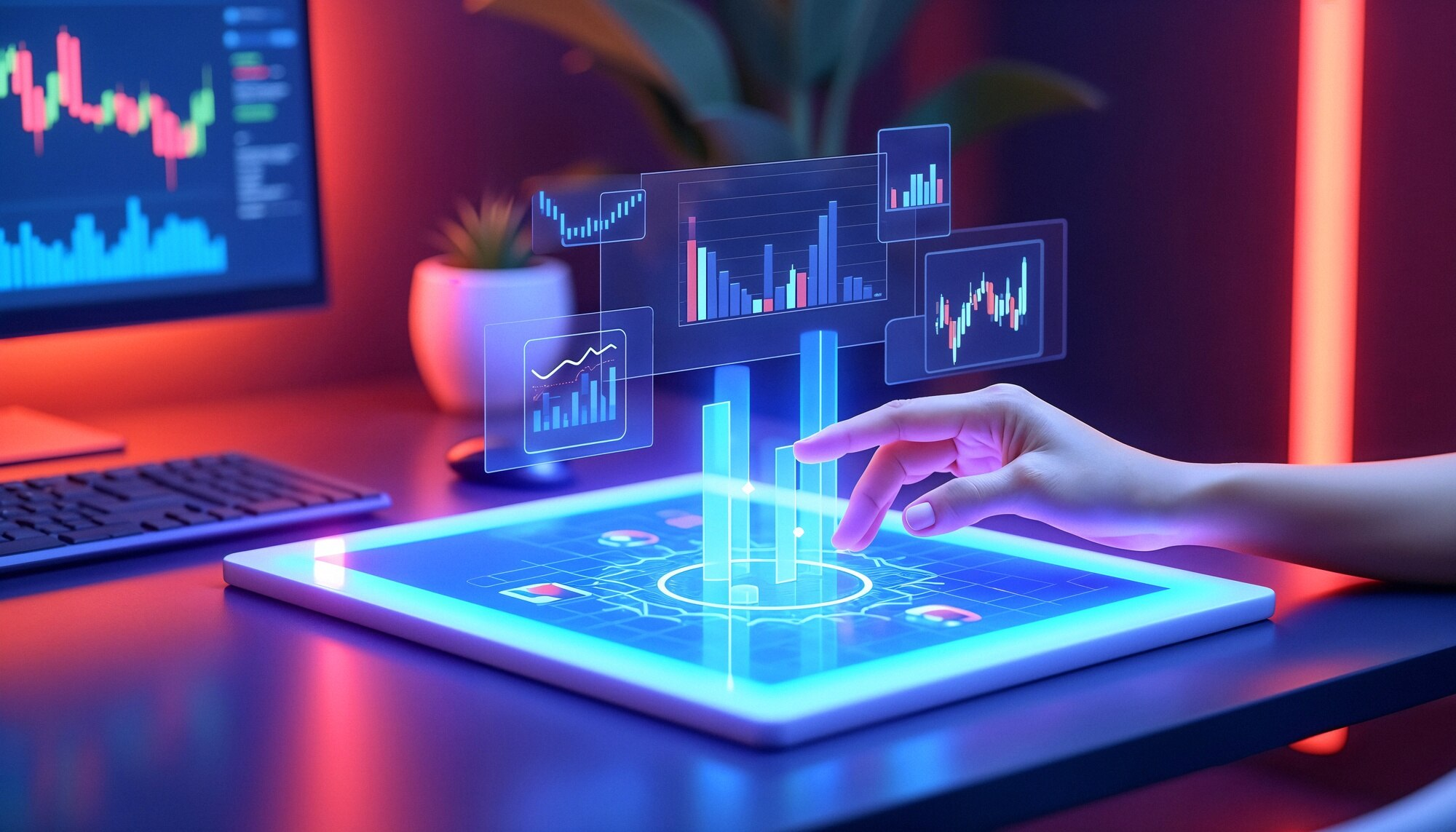AI agents are quickly becoming a big part of how businesses work. They can handle tasks on their own, talk to other systems, and help teams work faster and smarter. From answering customer questions to spotting fraud, these agents are now being used in many areas.
In this blog, we’ll walk you through the key trends shaping AI agent development in 2025, the most popular tools being used, and real-life use cases across different industries. Whether you’re new to AI agents or already exploring them, this guide will help you understand where things are headed—and how they can help your team.
Key Trends in AI Agent Development for Enterprises in 2025

1. Rise of Multi-Agent Systems
AI agents are no longer working alone. Multi-agent systems—networks of specialized agents collaborating on complex tasks—are becoming the norm. Much like human teams, these systems can divide responsibilities and problem-solve more efficiently. Whether it’s project management or advanced market analysis, the power of collaboration is proving vital. Capgemini reports that 82% of organizations plan to integrate AI agents by 2026, with multi-agent frameworks leading the charge for tasks like coding and data analysis.
2. Increased Specialization of AI Agents
One-size-fits-all agents are on their way out. In their place, we’re seeing a surge in highly specialized agents built for specific roles—be it customer support, financial planning, or software development. This trend boosts both performance and precision. According to CB Insights, 50% of equity deals in AI agents since 2020 have focused on domains like customer support and coding, highlighting the move toward niche solutions.
3. Real-Time Data Integration
Today’s agents aren’t just smart—they’re connected. AI agents are being built with seamless access to real-time data sources, APIs, and web tools. This enables them to make up-to-the-minute decisions in dynamic industries like finance, logistics, and media. Tools like Auto-GPT and AgentGPT are leading this shift, offering agents the ability to interact with the live web and enhance relevance and accuracy on the fly.
4. Democratization of AI Agent Development
AI isn’t just for engineers anymore. Thanks to no-code and low-code platforms, anyone can build an agent—from small business owners to solo entrepreneurs. This democratization is unlocking innovation at every level. Gartner predicts that by 2025, 70% of new enterprise applications will be created using no-code or low-code tools, signaling a major shift in who gets to build with AI.
5. Enhanced Autonomy with Human Oversight
AI agents are gaining autonomy—but not at the cost of control. Human-in-the-loop systems are becoming essential to ensure AI decisions align with ethical standards and regulatory guidelines. This hybrid model allows for faster, smarter outcomes without compromising on accountability. Microsoft’s 2025 Work Trend Index found that 75% of organizations using generative AI still rely heavily on human oversight—a clear indicator that trust matters.
6. Focus on Explainable AI
As AI becomes deeply embedded in sensitive sectors like healthcare and finance, the demand for transparency is growing. Explainable AI helps stakeholders understand how and why agents make decisions, building trust and reducing bias. It’s paying off: 92% of large companies report positive ROI from AI investments, with explainable systems leading to better adoption and fewer concerns about fairness.
7. Sustainable AI Development
The future of AI is also green. As environmental concerns grow, developers are prioritizing energy efficiency and carbon-conscious design. From lightweight models to carbon-neutral data centers, sustainable AI is becoming a business imperative. Microsoft’s pledge to be carbon-negative and water-positive by 2030 is just one example of how tech giants are setting the tone for environmentally responsible agent development.
Leading Tools for AI Agent Development for Enterprises in 2025

1. Microsoft Copilot Studio
A no-code platform empowering non-technical users to create agents for enterprise workflows like CRM and HR systems.
-
What makes it stand out:
Intuitive interface, deep Microsoft ecosystem integration. -
Key use cases:
Workflow automation, internal operations, business support. -
Did you know?
Over 100,000 organizations adopted it by October 2024—doubling in just a few months.
2. AutoGen
A flexible framework designed for building multi-agent systems using customizable templates.
-
What makes it stand out:
Support for collaborative agent workflows. -
Key use cases:
Coding assistance, multi-step automation, problem-solving tasks. -
Why it matters:
With 82% of companies planning to integrate AI agents by 2026, AutoGen is at the heart of this shift.
3. CrewAI
A platform for orchestrating role-based agents that simulate team collaboration.
-
What makes it stand out:
Agents operate like specialized team members with distinct roles. -
Key use cases:
Project management, customer support automation. -
Impact:
Contributes to the 25% enterprise adoption rate of AI agents projected for 2025.
4. LangChain
A popular framework for building context-aware AI agents integrated with LLMs, memory, and external tools.
-
What makes it stand out:
Modular design and tool integration support. -
Key use cases:
Smart chatbots, document processing, research agents. -
Insight:
A survey of 1,300 professionals found performance quality is the top concern—driving LangChain adoption.
5. Amazon Bedrock Agents
A managed service for deploying and scaling multi-agent systems in enterprise environments.
-
What makes it stand out:
Enterprise-grade reliability, scalable infrastructure. -
Key use cases:
Finance automation, healthcare systems, secure workflows. -
Update:
Multi-agent features were added in December 2024, broadening its capabilities.
6. OpenAI Swarm
An orchestration layer that coordinates multiple agents to handle complex tasks like data analysis and software development.
-
What makes it stand out:
Seamless agent collaboration and task distribution. -
Key use cases:
Coding, research, content generation. -
Scale:
Backed by OpenAI’s 400M weekly active users—driving wide adoption.
7. AgentGPT
A tool for creating real-time, autonomous AI agents with web access and automation features.
-
What makes it stand out:
Real-time decision-making and dynamic web integration. -
Key use cases:
Logistics, news curation, real-time insights. -
Industry trend:
63% of enterprises in 2025 are prioritizing real-time agent capabilities—making AgentGPT highly relevant.
8. LlamaIndex
A framework for building agents that can reason over private or domain-specific data using LLMs.
-
What makes it stand out:
Strong support for data-augmented workflows. -
Key use cases:
Market research, document summarization, enterprise knowledge agents. -
Why it matters:
As 71% of executives expect AI to drive workflow automation, LlamaIndex helps bridge the data gap.
Top Use Cases for AI Agents in Enterprises

1. Customer Service Automation
AI agents are transforming customer support by handling queries, resolving issues, and delivering personalized experiences—often in real-time. Industries like retail, finance, and telecom are leveraging these agents to reduce response times and improve customer satisfaction. For instance, Wiley reported a 40% boost in case resolution after deploying Salesforce’s Agentforce. With 85% of customer service reps now reporting time savings thanks to AI, it’s clear that intelligent agents are reshaping frontline support operations.
2. Workflow Optimization
Repetitive administrative tasks—such as data entry, scheduling, and internal reporting—are increasingly being automated by AI agents. This shift is helping IT and manufacturing firms streamline operations and boost employee productivity. Microsoft Copilot for Microsoft 365, for example, has been shown to increase productivity by 70% for routine tasks. As a result, many organizations report a 30% reduction in time spent on repetitive processes, freeing teams to focus on more strategic work.
3. Predictive Maintenance
In sectors like manufacturing and energy, AI agents are being used to monitor equipment, predict potential failures, and trigger timely maintenance actions. This proactive approach minimizes costly downtime and ensures continuous operations. Siemens has implemented AI agents on assembly lines to manage performance and reduce disruptions. Such agents are helping enterprises cut product development timelines by 30–50%, highlighting their impact on operational efficiency.
4. Personalized Marketing
AI agents are proving essential in analyzing customer behavior, segmenting audiences, and delivering personalized campaigns. Retail and e-commerce businesses are using these agents to increase engagement and conversions through hyper-targeted recommendations. Netflix, for example, attributes $1 billion in annual savings to its AI-driven recommendation engine. This mirrors broader trends, with 83% of AI-augmented sales teams reporting revenue growth in 2024 due to more precise targeting and automation.
5. Healthcare Diagnostics
In healthcare, AI agents support diagnostics, monitor patient vitals, and handle administrative documentation, helping doctors deliver faster and more accurate care. These agents are now critical tools in clinical workflows. One notable example involves AI agents used in CT image processing, which have achieved a 97% accuracy rate in detecting arterial plaque. With 90% of hospitals expected to adopt AI agents by 2025, their role in improving care delivery is rapidly expanding.
6. Financial Fraud Detection
Financial institutions are deploying AI agents to monitor transactions, detect anomalies, and flag suspicious activities in real time. These agents enhance fraud detection efforts and help meet regulatory compliance standards. IBM Watson, for example, is being used by banks to identify patterns and predict fraudulent behavior. As a result, enterprises in the finance sector have seen a 30–40% reduction in operational costs by integrating such intelligent systems.
7. Code Management and Development
AI agents are revolutionizing software development by automating tasks like bug fixing, code optimization, and repository management. Development teams can now move faster and more efficiently, reducing technical debt and deployment times. A case in point is Mitre’s AI agent, which successfully updated and repaired decade-old code to ensure system compatibility. As the trend continues, 60% of executives predict that AI agents will manage the majority of coding tasks within the next three to five years.
Final thoughts
AI agents are changing the way enterprises work, making everyday tasks smarter and more efficient. As these technologies grow, understanding the latest trends, tools, and use cases will help businesses stay ahead.
At Agentic AI Labz, part of Wow Labz, we’re passionate about creating AI agent solutions that fit your unique needs and help you unlock new possibilities. If you’re ready to explore how AI agents can transform your organization, we’re here to help every step of the way.

